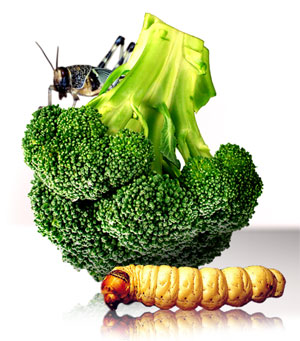4.1 The Development of Food Preferences
 |
| To Westerners, Brocolli suddenly looks appetising compared to what other cultures might consider acceptable as food. Locusts are still eaten in many parts of Africa and Witjuti Grubs are a delicacy of the Australian Aborigines. |
Food preferences are influenced by many variables. We have determined the most fundamental of these in the chapters on "The Senses" (see section 1). There it was illustrated how our senses of taste and smell perform initial qualitative assessments, discriminating toxic or off substances from nutritious foods & liquids, before they are ingested. These are reflexive reactions to basic tastes: the preference for sweet and salty tastes, and the rejection of sour and bitter tastes.
Our genes help to determine how we detect these basic tastes by influencing the configuration of taste receptors, says Leslie J. Stein, PhD, from the Monell Chemical Senses Center in Philadelphia."Part of why you might like broccoli while your best friend finds it bitter is because you have different genes, which code for different bitter receptors. We can't change our genes, so some food likes or dislikes may be difficult to alter drastically. Repeated exposure can increase relative liking for a food but may not be able to change a disliked food into one that is liked. In other words, exposure may make a disliked food less disliked."
Linda Bartoshuk, professor of otolaryngology and psychology at Yale University, is one of the leading scientists researching genetic variation in the ability to taste. In the 1990's enough data had accumulated to show that one group of the population were more sensitive tasters than another. Such 'super-tasters',"live in a 'neon world' of taste, while non tasters are in a pastel world" she explains. In fact, about 25% of the American population are born 'super-tasters', a group with an unusually high number of taste buds. This higher than average number effects the way food tastes, and consequently, food preferences, diet and health."For example, [super tasters] eat less fruits and vegetables that contain bitter tasting flavanoids. Since flavanoids [antioxidants] are thought to play a role in preventing colon cancer, super tasters are more at risk for colon cancer. At the same time, super tasters dislike and avoid fatty and sweet foods. Thus they tend to be thinner and have a lower risk of for cardiovascular disease."(1)
But taste preferences are not solely determined by our genes. Environment, experience and age play a part and their contribution begins even before birth. During pregnancy, taste buds form in the infant in the seventh-week and the amniotic fluid acquires the odour of the food consumed by the mother, passing on information about her diet. A child's acceptance of healthy foods can be increased by mothers varying their diets during pregnancy and breastfeeding.(2)Todays diabetes & obesity epidemics are partly attributed to baby food formula made with high fructose corn syrup. This single ingredient tastes good to nearly everyone under the age of thirty five. That's because most people are raised on it and continue to consume it in various forms such as breakfast cereals, biscuits, lollies, granola bars and pizza sauce. People raised on non-sugar diets, on the other hand, are often found to dislike the taste of excessive sugar with carrots and tomatoes representing their maximum tolerance for sweetness. The conclusion is that teenagers and adults choose foods and beverages based on what they are fed as infants.
However, we also know that taste preferences change over time. Our taste buds decrease in number as we age, and according to Adam Drewnowski, Ph.D., director of the nutritional sciences program at the University of Washington, there's another biological reason for this shift."...changes in taste are in service of energy needs," says Drewnowski."When you're younger and growing, you need to maximize energy. You need sugar and fat."As we age and become less active our energy needs decline, often leading us to prefer low-calorie foods like spinach and grapefruit.
Other research by the Human Nutrition Programme, at the school of Public Health at the University of Michigan has found that taste responses are influenced by a range of physiological, metabolic and genetic variables. (Food author H.D Renner maintained that fish was found to be unpleasant to South and East African Negroes, Mongol tribes and Navahos in New Mexico. Beef caused nausea in Hindus whilst Chinese and Parsees found it unpleasant.)(3)
There may be types of cuisine which particular races are not genetically adapted to consume.
Food preferences and food choices of populations are further linked to attitudinal and social variables and perhaps of most relevance in modern times - variables such as income and economic and industrial development.
In more dire environments, an uncertain food supply has dictated food preferences.
Such conditions made many primitive peoples almost omnivorous. Shellfish, sea urchins, frogs, toads, snails, mice, rats, spiders, earthworms, scorpions, moths, centipedes, caterpillars, lizards, snakes, dogs, horses, roots, lice, locusts and other insects and the eggs of reptiles and birds - there is not one of these which was not eaten amongst primitive cultures and many are still eaten today. Archaeologists claim that broken bones and cracked skulls discovered at several sites prove that primitive peoples also ate human brains and bone marrow. If they did this, there is little doubt that they would have eaten human flesh. A recent find has revealed some of the best preserved and most meticulously gathered data in support of the argument for early cannibalism. At a six thousand year old site at Font Bregolia near Nice there were bones from many butchered animals including sheep, goats, boar and deer. All had been routinely slaughtered, the finders say, and the bones broken to extract marrow, then unceremoniously discarded. Human bones were found among the animal ones. They had been treated in exactly the same fashion. Three human adults, two children and one person of undetermined age had certainly been eaten by other people. The remaining human skeletons showed less certain signs of cannibalism.
 |
| Les Cannibales, by Francisco de Goya y Lucientes, 1800. |
We respond to such facts by imagining the desperation of the primitives situation. Even today, in times of starvation people are driven to eat dead companions in order to save their own lives. If there has been no actual murder, and if the eating has been done with reverence for the solemnity and dire necessity of the action, then such a measure is even considered forgivable.
But anthropologists have learnt that some primitive peoples clearly developed a predilection for human flesh. Cannibalism has been found in nearly all primitive tribes even among such later peoples as the Irish, the Iberians and the eleventh century Danes. Bodies were a staple of trade and funerals were largely unknown. The Feugians ranked women as food above dogs because, they said,"dogs taste of otter."In Tahiti an old Polynesian chief explained his diet:"The white man, when well roasted tastes like ripe banana."The Fijians however, complained that the white man was too salty and tough, and that a European sailor was hardly fit to eat.(4)
Aside from such cultural aberrations, we picture early peoples in a long series of trial and error , experimenting with the tastes of local flora and fauna, to find, often at much cost to their health, which articles could be eaten safely and which could not. Articles could then be confidently added to the growing list of recognised animals, fruits, nuts, berries, yams and other food sources in their environment. We can imagine that where food preferences were first cultivated, they must have being in moments of abundance rather than desperation, and probably coincided with fire. Heat broke down meats and the cellulose and starch of plants previously indigestible in their raw state. Cooking presented new flavours, and introduced an element of pleasure to meals that went beyond mere satiation.
Regional Influences on Taste Preferences
With successive generations, agri-cultures developed recipes, and the practice of cooking (the intentional preparation of foods in the traditional manner of a particular social or ethnic group). Tradition and religious rites were probably integral to this process to instill a communal memory of what could or could not be eaten, and how a particular item should be prepared. This living 'memory' has permeated from individuals, through to families, collected in cultures and then civilizations, and over time has formed the basis of the cuisines of the world.
Influencing traditions of cuisine were the local climate, terrain, soil, flora and fauna. The common assumption regarding the development of regional cuisine has been that it was based upon the kind of produce that could be best grown. For example, some sites were more suited for crops, others for fruits, whilst yet others, too steep or too flat for agriculture, were more suited to animal husbandry. Indeed, there are regions now famous for wheat, rye, potatoes, maize, pasta, rice, wine, beer, oil, butter, dairy produce, onions or pork, each conditioning the local economy. 'Terroir' certainly plays an important part in what communities have available to eat, however, it does not explain the difference in cuisine that can be found in food styles between villages, when the available raw materials are much the same.
H.D Renner, in his book,"The Origin of Food Habits", makes some interesting comments on this pont."It can quite frequently be observed" he writes, "that some food habits change every thirty miles. This is true usually of methods of preparing food. Raw materials remain much the same over wide areas, in some cases they are identical throughout the nation, or nearly so. Most people feel no longer at home as soon as they get somewhere where the food is different. Again, to find the same food at another place is taken as an important sign of kinship."(5)
This poses questions."Is the development of regional cuisine part of a social marking system, which designates the territorial boundaries of communities? Is there an instinct to mark out one's territory by developing a food style that is served to all the inhabitants of that community?"
We know that in many cultures, religious food taboos conveying ideas of cleanliness or of safeguarding the social structure exist. Some taboos were developed for cultural and religious reasons (today finding their commercial counterparts in advertising), for separating one social unit from neighbors. For example, the Moslem prohibition of alcoholic beverages was most likely aimed at distinguishing the new religion from the alcohol drinking Christians. Similarly, Jewish Kosher products were probably to prevent the mingling of Jews with gentiles, thus maintaining the purity of the bloodline. Diet becomes a social signal and one mans food, like his religion - is always regarded as the best. In the same way, monastic communities and people with strict moral standards will tend to live on "spiritual food" , maintaining a sparse diet. Tell me what you eat and I will tell you what you are.
It may be too simplistic an explanation to suggest that whilst the raw ingredients of an area were the same, different food styles were developed as a form of communal territorial marking. Subconsciously this may have played a role, but other factors require consideration.
Outside of the city, communities were historically limited in their contact with one another. Mobility was by foot or horse, or animal drawn carts was slow, placing a barrier of time and space between inter community relationships. Each communities geographical location, its proximity to lakes, rivers, oceans, mountains and the like would determine the range of crops and animals available, which necessarily influenced local cuisine. As transport evolved so too did trade, and goods could be moved quickly and safely between an ever increasing circle of regions. A reliance on commerce broke down regional barriers; traditions which developed over centuries were diluted or encouraged.
Later, populations moved from the countryside into the cities, creating the need to feed concentrated populations on a grand scale. Agriculture and the pursuit of food production on a subsistence level moved to another plane. A new type of standardised non regional, 'non cultural' food began to emerge. Some will argue that it does have a culture - an industrial culture - a cuisine promoted not by culinary skill or creative endeavor, not by the pursuit of pure flavour or harmonious combination of component parts but by a need for fast, efficient satiety.
Modern marketing and distribution methods in western society have broken down all traditional barriers of cuisine, and it is virtually impossible to go to any city in western society and not find strong links to the cuisine of other regions and cultures. As commercial and cultural exchanges increase, diets also become more varied and complex making thousands of years of culinary refinement readily available.
The danger today is the widespread proliferation of 'tricked up foods' which have been designed in laboratories by food technologists and scientists. New foods can be developed by altering the genetic structures of plants and animals. Programmed flavour compound release rates and timed textural changes can now be created. Chewability can be measured. Every part of the process can be designed and calculated, and whilst it may provide food for an ever increasing population, the sameness of that food will dull our lives as what we eat becomes less and less dependent upon seasonal variation or even the seasons themselves. As the food technologists standardise the cuisine of the 21st Century, advertisers and their agencies reinforce an international culture.
Standardised tastes for all may be the ultimate price of the global village.
 A High With Your Fries? A High With Your Fries?What if some obese people are actually victims of the type of food sold in fast-food outlets? Absurd as it may sound, there is a growing body of evidence pointing in this direction. Fats and simple sugars can act on the brain in the same way as nicotine and heroin. John Hoebel, a psychologist at Princeton University in New Jersey, is interested in whether it is possible to become dependent on the natural opioids released when you eat a large amount of sugar. Along with a team of physiologists from the University of the Andes in Merida, Venezuela, Hoebel recently showed that rats fed a diet containing 25 per cent sugar are thrown into a state of anxiety when the sugar is removed. Their symptoms included chattering teeth and the shakes -- similar, he says, to those seen in people withdrawing from nicotine or morphine. What's more, when Hoebel gave the rats naloxone, a drug that blocks opioid receptors, he saw a drop in dopamine levels in the nucleus accumbens, plus an increase in acetylcholine release. This is the same neurochemical pattern shown by heroin addicts as they go into opioid withdrawal (Obesity Research, vol 10, p 478). "The implication is that some animals -- and by extension some people -- can become overly dependent on sweet food," says Hoebel. "The brain is getting addicted to its own opioids as it would morphine or heroin. Drugs give a bigger effect, but it's essentially the same process." As yet no one knows how a big hit of fat and sugar compares with a dose of, say, heroin. But Hoebel says: "Highly palatable foods and highly potent sexual stimuli are the only stimuli capable of activating the dopamine system with anywhere near the potency of addictive drugs." Ann Kelley, a neuroscientist at the University of Wisconsin Medical School in Madison, has uncovered more evidence that the release of opioids in the nucleus accumbens tells your brain to keep eating. She found that if rats' opioid receptors are overstimulated with a synthetic enkephalin, the rats eat up to six times the amount of fat they normally consume. They also raise their intake of sweet, salty and alcohol-containing solutions, even when they are not hungry. Kelley has also discovered that rats that overindulge in tasty foods show marked, long-lasting changes in their brain chemistry similar to those caused by extended use of morphine or heroin. When she looked at the brains of rats that received highly palatable food for two weeks, she saw a decrease in gene expression for enkephalin in the nucleus accumbens. "This says that mere exposure to pleasurable, tasty foods is enough to change gene expression, and that suggests that you could be addicted to food," says Kelley. (6) |

1. From "Supertaster" to the Taste-Blind, by Cristian Boboila. Yale Scientific Magazine, Summer 2004.
2. Catherine Forestells, from the Monell Chemical Senses Center (2006).
Other studies have concluded that a child's taste for protein-rich foods like meat and fish is inherited, but preferences for vegetables and desserts are influenced.
3. The Origin of Food Habits, by H. D. Renner. Faber and Faber Ltd., London. 1944.
4. Our Oriental Heritage (The Story of Civilization, Vol.1), by Will Durant MJF Books (Reprint July 1997
5. The Origin of Food Habits, by H. D. Renner. Faber and Faber Ltd., London. 1944.
6. Excerpts from "Burgers on the Brain: Can You Really Get Addicted to Fast Food?", New Scientist Magazine, February 2003
